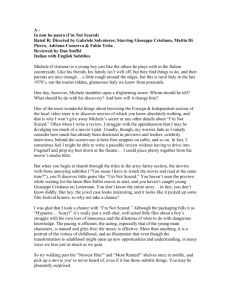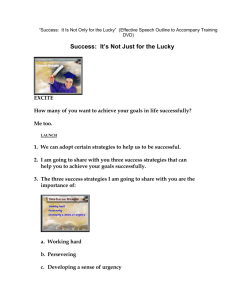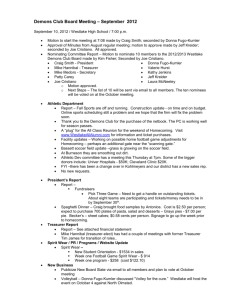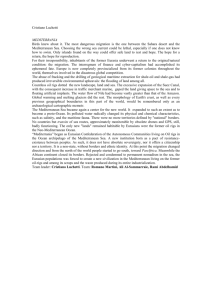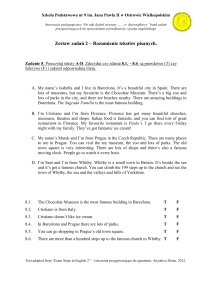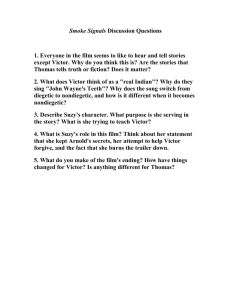Management Project (report)
advertisement
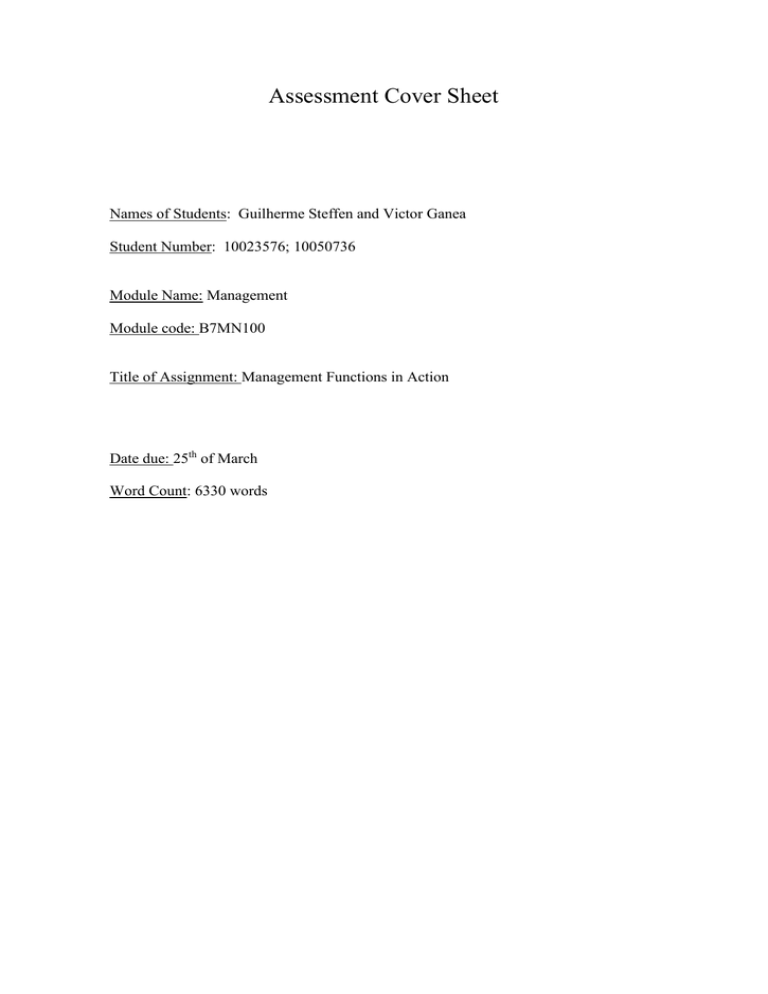
Assessment Cover Sheet Names of Students: Guilherme Steffen and Victor Ganea Student Number: 10023576; 10050736 Module Name: Management Module code: B7MN100 Title of Assignment: Management Functions in Action Date due: 25th of March Word Count: 6330 words Management Function in Action Table of Contents PART I Introduction .......................................................................................................3 PART II Planning ............................................................................................................4 PART III Organizing ......................................................................................................7 PART IV Leadership and Motivation .........................................................................11 PART V Controlling......................................................................................................16 PART VI Conclusion .....................................................................................................18 Figures ............................................................................................................................21 References.......................................................................................................................23 Appendices (Meeting notes) ..........................................................................................24 Self-evaluation reports ..................................................................................................25 2 Guilherme Steffen 10023576 | Victor Ganea 10050736 Management Function in Action Introduction As students of management we were requested to conduct an interview with questions based on the content studied throughout the academic year. This interview has as its objective to analyse the difference between what we studied in the classroom and the real life management. Primary and Secondary research was conducted for this report. The functions of a manager could be numerous, the level of the manager also implies on the activities he has to complete. In order to provide a better understanding of the managerial functions, they were divided into four big categories. Planning, Organizing, Leading and Controlling. We studied each of these categories separately and in the end we linked the managerial functions that are related between the categories. The manager we chose is Cristiano Diefenthaeler a middle manager from Sick Ltd. Sick was founded in 1946 and today is world leader producer of sensors and sensors solutions for industrial application. The total group sales for 2013 was the amount of EUR 1,009.5 million and the company employs over 6.500 people worldwide. Sick Brazil initiated its activities recently with the acquisition or merge of the company Cristiano used to work. The company in Brazil went through a recent project of change and as a result Cristiano was able to tell us some of the strategies that are being implied in order to complete targets set by the headquarters of the company located in Germany. As a middle manager of a company located in two distinct countries, we attempt to illustrate the difference between the managerial style used in a undeveloped country in comparison to the style used in a developed economy. We believe that this report exemplify the culture impact when managing and taking decisions. Some of the theories were again researched and analysed in a different point of view, we tried to bring into the report real life examples and link the theory we learned in class with our research as well as the answers of our interviewee. 3 Guilherme Steffen 10023576 | Victor Ganea 10050736 Management Function in Action Planning In modern organizations managers are often requested to, based on the company strategy, achieve goals which are set in order for the organization to succeed. These goals are often a hard challenge for managers who are responsible for not only set the objectives but also determining a course of actions required to achieve these objectives. This means managers should be concern on what is to be done and how it is to be done. The manager that we interviewed is a middle manager who works in two units of the organization, and respond to the headquarters of the company located in Germany. He currently has 44 people under his span of control. Having to achieve goals which were set for a whole unit of the organization located in a different country, Cristiano claim that Planning is of extreme importance because it is the basis of all the other managerial functions. There are different types of plans and planning. In our course we defined that strategic planning involves analysing opportunities and threats, as well as the strengths and weaknesses of the entire organization. We learned that strategic planning has a long-time frame, usually 3 years or more and it is often based in the organization mission and values. Cristiano said that his company strategic plan is for at least two years, on the other hand he affirmed that the company has plans and goals set up to 2020. To any manager be able to plan in long or short term, it is crucial that the organization has a good method for data collection. One of the biggest challenge is to find good data from reliable sources. The data of Cristiano Company is collected through market research with customers, suppliers and also competitors. They also use of specialised magazines and financial websites to increment the research. For analysis of the data collected the company uses the SWOT methodology, which provides a visual overview of the entire business and enables them to identify and understand key issues and opportunities affecting the company. In order to facilitate the understanding of the planning process and help managers complete missions in a more effective way we learned the six steps of the strategic management process. We strongly believe that the six steps are recommended but are not a recipe for creating a strategic plan. According to Cristiano in practice you will hardly review every step of the process but you will identify the steps that require more attention and fix possible issues within the plan. We believe that the mission, objective and strategy of the organization should be clear and the focus of any organization, 4 Guilherme Steffen 10023576 | Victor Ganea 10050736 Management Function in Action additionally in day-to-day life all the others steps are modified and analysed constantly in the course of the business because of changes in the market. In order to collect data for this report we informally asked a few managers, including Cristiano, which one was the hardest step of the managerial process. The answers were similar between the managers, the decision making step. Digging into research we could conclude that people have this desire to protect themselves from the wrong decisions or, more properly, from the consequences of the wrong decisions. Psychologists understands that the skill of decision making it is extremely important to any person. As a result, there are numerous strategies available with the aim of assist in this process. As business students we studied the 7 steps of the decision making which were proposed by Pam Brown of Singleton Hospital in Swansea, Wales. Cristiano affirmed he uses the 7 steps as a support on the decision making process but he believes that what counts is the experience and evaluation of all factors involved. We believe that all the decisions are based on the experience of the manager. Important decisions should include more than one person, in order to compare experiences and point of views related to the decision. Based on our research we found that in cases where the manager needs to take action, they should trust their intuition and use any of the strategies available to support the process. In general there are three levels of strategy that organisations implement, which are corporate-level, business level and functional level strategies. Corporate level strategy occupies the highest level of strategic decision making and address the entire strategic scope of the enterprise. The strategy covers actions dealing with the objectives of the firm, which market to compete and in which geographical locations the firm will operate. It is also the strategist responsibility for diversification, new products and even retrenchment if it’s needed within the organization. As we previous stated, corporate level strategists have a lot of responsibility in the results of the firm, this is often a challenge due the complexity of the strategies. With the aim of reduce this complexity the corporate level strategy can be divided into three categories, or three grand strategies which are the growth strategies, renewal and stability strategies. Cristiano briefly explained that the company he used to work was recently acquired by Sick Ltd as a part of their growth strategy using the horizontal integration in order to expand markets. Sick Ltd is a German company that wanted to enter in the Brazilian market of sensors and in order to increase competitive strengths and lower competitors among the industry decided to acquire a Brazilian firm which were 5 Guilherme Steffen 10023576 | Victor Ganea 10050736 Management Function in Action operating in the market for the last decade. With the experience in the market and good reputation the acquisition was a success and they have been focused in the growth strategy to achieve annual targets until 2020. As the company is going through a renovation process of its whole structure, they are planning to achieve growth by reducing costs without reducing customer service and differentiating its products from their competitors. It is extremely important that all the company employees have knowledge of the company strategies. Employees who understand the strategy are able to make day to day decisions more efficiently and that supports the company vision and goals. We discovered again that in practice this can be a very hard challenge. When we studied visionary entrepreneurs like Ricardo Semler we may not had understood the importance of having one sit reserved for anyone from any department to attend the company meetings. This was strategically planned to equalize the power of employees and the board and also to make them a bit more involved with the company management. In Sick Ltd, Cristiano affirmed that when the strategies are being designed and planned they have meetings which at least one person of each department it’s attending. In order to inform their employees of the strategies they have an annually meeting which happens right after the board meeting. The company goals are set based on the means-end chain hierarchy. The goals are integrated until you reach the base of the structure. As an example Cristiano stated that the top manager set that the company needs to increase the sales by 20% by the end of the year. Middle manager of a product states that they need to increase the amount of market share of a product. Local Manager define that his team should increase the sale in 20,000 units in the State of Rio Grande do Sul. Planning it is one of the most important managerial tasks, it is the basis to all the other functions. It is concerned with creating procedures, guidelines and rules for achieving the goals and objectives of the enterprise. In the topic above we approached different topics about planning, such as strategic planning, collection of data, the 6 steps of strategic management process, the decision making process, the company goals and its strategy of differentiation. 6 Guilherme Steffen 10023576 | Victor Ganea 10050736 Management Function in Action Organizing The basic concepts of organization design were formulated in the early 1990s by management writers offered a set of principles for managers to follow. More than 20 years have passed since most of those principles were originally proposed. In this section we will discuss about six basic elements of structure: work specialization, unity of command, span of control, authority and responsibility, centralization and decentralization, and departmentalization. We did a research and figured out that nowadays almost all the companies use a modern organizing model, using a work specialization and the unity of command. Work specialization is a component of organization structure that first of all involves having each discrete step of a job done by a different individual rather than having one individual do the whole job and send increase the efficiency and the productivity of the company. In fact, back in the 1700s when economist Adam Smith published Wealth of Nations, he advocated that jobs should be divided into small parts. Overall, this component of organization structure is alive and well in most organizations today, in this case SICK Ltd. is not an exception. We have to recognize the economies it provides in certain types of jobs, but we also have to recognize its limitations. An employee who has to report to two or more bosses might have to cope with conflicting demands or priorities. Accordingly, the early writers believed that each employee should report to only one manager, a term called unity of command. As a sample we can say the same about SICK Ltd. which is using this management principle because in most instances, strict adherence to the unity of command creates a degree of flexibility that hinders and organization's performance. The span of control is the number of subordinates a manager can direct efficiently and effectively manage. However, several writers argued that as a manager rises in an organization, he/she has to deal with a greater number of ill-structured problems, so top managers need a smaller span than do middle managers, and middle managers require a smaller span than do supervisors. Our manager, Cristiano Diefenthaeler, has the span of control of 44 people as we sad at the start, and there is no limits in his opinion, he think that if the company has defined assets and processes and if all the employees are well trained and know the processes, then a manager can get 7 Guilherme Steffen 10023576 | Victor Ganea 10050736 Management Function in Action easily a bigger span of control. When you have a competent team that knows the process is easier to work with large groups. Authority refers to the right inherent in a managerial position to give orders and expect the orders to be obeyed. Authority was a major tenet of the early management writers; it was viewed as the glue that held the organization together. It was to be delegated downward to lower-level managers, giving them certain rights while providing certain prescribed limits within which to operate. The authority remains with the position and its new incumbent. When managers delegate authority, they must allocate commensurate responsibility. That is, when employees are given rights, they also assume a corresponding obligation to perform. Our manager, Cristiano Diefenthaeler like all managers nowadays delegate authority and responsibility to all employees, first he delegate it and then practice the supervisors, through reports and meetings, because meetings are a necessary part of operating in a professional environment. The terms authority and power are always confused nowadays. As we sad above authority is a right, the legitimacy of which is based on the authority figure’s position in the organization in addition to power refers to an individual’s capacity to influence decisions. Authority is part of the larger concept of power. That is, formal rights that come with an individual’s position in the organization are just one means by which an individual can affect the decision process. There is five types of power that a manager can use to his employees (see exhibit 2.1). As an example we have our manager Cristiano who is using different models depending on the employee or department. Like an example he gave us the commercial department that the methodology used in his organization is the reward power. According to specialist it is important to learn how to recognize each type, and how to use each type effectively in business situations, and Cristiano is using all this types of power successfully and that is a great achievement for him and for the organization. When an organization is passing to decision-making process a good think to decide at what level are decisions made in your organization. Centralization or decentralization? However, is not an either-or concept. Rather, it's a degree phenomenon. Centralization is a function of how much decision-making authority is pushed down to lower levels in the organization, the higher the level at which decisions 8 Guilherme Steffen 10023576 | Victor Ganea 10050736 Management Function in Action are made. Decentralization is a function of how decision-making authority pushed down to the lowest level of the organization, to the closest level to the problems. According to Cristiano’s experience, in practice he use a mix of both, like all modern managers, he chosen the right amount of centralization and decentralization that will allow them to best implement their decisions and achieve organizational goals, he also is working for decision-making process with the levels of responsibility that allows him to achieve company’s goals easier and on an organizational level the benefits are even great. Early management writers argued that activities in the organization should be specialized and grouped intro departments (called departmentalization). Work specialization creates specialists who need coordination. This coordination is facilitated by putting specialists together in departments under the direction of a manager/leader. These departments are typically based on the work functions performed, the product or service offered, the target customer or client, the geographic territory covered, or the process used to turn inputs intro outputs. The method or methods used should reflect the grouping that would best contribute to the attainment of the organization’s objectives and the goals of individual units. Cristiano Diefenthaeler in his organization is using a mix of all of them (ie. Product, geographic areas and customers help them to identify what the best product for particular customer and region) that allow the company to achieve economies of scale in that it can centralize all the resources it needs and locate various experts in that area and is a good coordination within the function because the top managers can easily direct and control various departments’ activities. Organizational structure is a type of framework used in business. Its purpose is to find the most effective way to delegate roles, power, and responsibilities to its employees and departments. Based on an organizations goals and objectives it may be structured in many different ways. Two important structures include Mechanistic and Organic Structure (see exhibit 2.2). Mechanistic structure are mainly for companies that operate in a stable environment, use a centralized approach of authority, and maintain strong loyalty for management. In a nutshell we can say its bureaucracy, it’s a structure that is high in specialization, formalization, and centralization. On the other hand, the organic structure are used in organizations facing unstable environments and must possess the ability to change accordingly. In brief we can say it’s a structure that is low in specialization, formalization, and centralization. As an example we can say about SICK Ltd. where our manager Cristiano is using the mechanistic structure, he think 9 Guilherme Steffen 10023576 | Victor Ganea 10050736 Management Function in Action that’s the best type of structure that can fit his company’s needs. Cristiano is satisfied using this structure because everything looks clear and it is structured. The benefits of this structure also are that belief upper management is better capable of making decisions and the employees are more jobs specialized and placed into certain departments. Change is a common thread that runs through all businesses regardless of size, industry and age. Our world is changing fast, and, as such, organizations must change quickly too. The concept of “change management” is a familiar one in most businesses today. But, how businesses manage change and how successful they are at it varies enormously depending on the nature of the organization. According to the specialist and to Cristiano’s experience the main external factors that can create the need of changing are the economy and the market (ie. competition). And the key part of changing process depends on how far people within it understand the change process. We studied this year that a good change process was developed by Kurt Lewin in 1950s and still holds true today because is one of the cornerstone models for understanding organizational change. The process is really easy to understand, consisting of 3 steps as UnfreezeChange-Refreeze (see exhibit 2.3). That’s just the theory, but according to our manager Cristiano in practice is a bit different, in his organization he don’t use this change process, he utilize methodology and feasibility studies for the discussions that this change may result in the organization. At the moment SICK Ltd. is currently undergoing a process of modelling, and in this organization the change process in going on the lower level, working close to people and structure. As a conclusion, we can say that Cristiano Diefenthaeler given today’s uncertain economic environment he understand the basic principles of the structural change and development in his organization. He use modern strategies and is evaluating the process to the lowest level in organization and working close to people and to structure because that’s the key part of changing process making all the people within organization to understand the change process and its benefits. This organization is using a mechanistic structure in the that make them better capable to make decisions and the employees are more jobs specialized and placed into certain departments. 10 Guilherme Steffen 10023576 | Victor Ganea 10050736 Management Function in Action Motivation and Leadership Motivation can be described as the level of desire the employees feel to perform efficiently towards the company objectives, simultaneously satisfying personal needs and helping the organization attain its goals. According to Mithcell T.R (1982) motivation, ability and environment are the major influencers over employee performance, in other words, motivation on its own it is not sufficient to improve employees productivity levels, but it is a major influence, that as involving human beings becomes another challenge for managers. We studied a few theories that help us to understand how we motivate people. The very first theory most students and managers are familiar with it’s the theory of needs created by Maslow in 1943. Maslow stated that we could divide a person needs into five stages that are hierarchically ranked. As we satisfy the basic needs, we start looking to satisfy higher needs. Once we satisfy the need, it no longer serve as a motivator. Cristiano believes that motivation is key for achieving success, he studied the Maslow theory in college but he affirmed that although the concept applies in real life, it is a hard challenge to identify the employee need. The difficulty arise when we understand that every employee is distinctive, and as a result applying the same treatment as an attempt to fulfill their needs is often a useless movement. We also identified that the theory changes in relation to the environment and the economy of the country. Cristiano believes that in Brazil, as a result of the strong uncertainty of employees, the majority of the population is concerned about Job Security, this means that satisfying this need there, would imply in a stronger impact in the employee motivation when compared to other countries. Clayton Alderfer made a slight modification in Maslow theory and created the ERG Motivation theory, which he divided the five human needs into three big categories, existence needs, relatedness needs and growth needs. The main difference between the two theories is that the ERG theory understands that at a given point of time more than one need may be operational in a person. It also excludes the hierarchy created by Maslow, this results on what is called frustration- regression aspect of ERG theory. 11 Guilherme Steffen 10023576 | Victor Ganea 10050736 Management Function in Action Douglas McGregor was an American social psychologist who proposed the XY Theory. Basically what we need to cover is that the managerial style will depend and have a strong influence on the manager believes and assumptions about its employees. If the manager believes that his employees dislike work he will tend towards a classical style of management. On the other hand, if the manager thinks his employees take pride in doing a relevant job towards the company goal, the manager will tend towards a more participative style. Cristiano commented saying that he believes that again this is strongly related with the economy of the country. He believes that if the country is developed the amount of Y employees would be greater than in an undeveloped countries due to the level of education and training. Herzberg researched and approached the question differently. He proposed the two factor theory which says that the aspects that satisfy employees are very different from the aspects that dissatisfy them. (See Figure 3.1) The Hygiene Factors does not necessarily increase satisfaction among the employees. In contrast, the motivators or satisfiers when these questions are solved it increases job satisfaction and performance. Cristiano strongly believes that motivation is one of the manager key responsibilities, he affirmed that Sick Ltd has frequent meetings and surveys along the employees in order to identify the satisfaction of the employee in relation to the company and environment of work. It is known that as human beings we compare ourselves and our results with other people. As a sales manager Cristiano believes that this comparison motivates employees when they have good leaders working among the selling force. These selling people motivates towards growth, they are always trying to reach success and meet sales target. We can classify these people as a high achiever, from McClellands acquired needs theory, which states that these people are strongly motivated by job situations with responsibility and an intermediate level of risk. Cristiano affirmed that in Sick Ltd all their employees has a chance to be promoted and they are all rewarded based in their production. He strongly believes in the meritocracy used by the company. When asked about the equity theory, he agreed that we compare ourselves and stated that this theory explains why giving one person a promotion or a pay rise can demotivate the rest of the staff. We discovered that when setting the goals and targets for the sales force, a higher target not necessarily will imply a higher level of motivation, in fact he believes that a target that wasn’t planned 12 Guilherme Steffen 10023576 | Victor Ganea 10050736 Management Function in Action accordingly would demotivate the staff. Today Sick Ltd has a profit sharing programme and the sales targets are well rewarded when reached. Behind a successful organization there is a good leader, and the leader plays one of the main roles in the success of the company. Leadership is the action of leading people in an organization towards achieving goals. Leaders do this by influencing employee behaviours in several ways. A leader sets a clear vision for the organization, motivates employees, guide employees through the work process and builds. Nowadays the terms manager and leader are always confused. Managers are appointed, they have legitimate power that allows them to reward and punish. On the other hand, leaders may either be appointed or may emerge from within a group. Leaders can influence others to perform beyond the actions dictated by formal authority. Every manager should be a leader as well because this two are interactive to each other. In our case we can show as an example Cristiano Diefenthaeler who is a leader according to his experience and knowledge. He considers himself a good leader who possess main characteristics of a leader: honesty and integrity, focused, self-reliance, great communicative skills, hold relevant knowledge to work, enthusiastic and intelligent. In his opinion the team should possess credibility in their work and truly trust their manager and should be a good relationship of trust and reciprocity. Because trust appears to be primary attribute associated with leadership, is a positive expectation that another will not act opportunistically that can be manifested through words, actions, and decisions. This is what Cristiano means by his experience a successful leader. One of the first studies of leadership behaviour was done by Kurt Lewin and his associates at the University of Iowa. In their studies, the researchers explored three leadership behaviours or styled: autocratic, democratic, and laissez-faire. An autocratic style is that of a leader who is typically tends to centralize authority, dictate work methods, makes unilateral decisions, and limits employee participation. A leader with a democratic style tends to involve employees in decision making, delegates authority, encourages participation in deciding work methods and goals, and uses feedback as an opportunity to coach employees. This technique totally describe our manager’s leadership style who really take care of his employees. And finally, the laissez-faire leader generally gives his or her employees complete freedom to make decisions and to complete their work in whatever way they see fit. According to Cristiano, he is using 13 Guilherme Steffen 10023576 | Victor Ganea 10050736 Management Function in Action the democratic leadership technique because it creates a positive work environment and a result employees will do a better job it also creates job satisfaction that stimulates a sense of participation, control and autonomy among the employees. As a manager Mr Diefenthaeler emphasis on human and personal aspects of his team as well as technical skills and goals, he believes that the last two should be the focus of the company to maximize production and profitability. Paul Hersey and Kenneth Blanchard’s leadership model has gained a strong recognition among management students and specialists. Called Situational Leadership, it shows how a leader should adjust his or her behaviour in order to successfully guide his staff towards the company goals and objectives. They identified four specific behaviours. (See Figure 3.2) Our manager Cristiano defines himself as a selling style of leader, this means that he put as priority both, the high relationship and the high focus on the tasks. This allows him to provide both the path to be traced and the support along the walk. In his opinion this model is the best one that allows you to lead your team in a friendly environment and to achieve company’s goals successfully. Situational Leadership has an intuitive appeal. It acknowledges the importance of follower and builds on the idea that leaders can compensate for lack of ability and motivation of their followers. Numerous of leading theories have been studied in the United States. It is known that leaders are distinctive in different parts of the world. For example, in Japan, the leaders are seen as very humble and communicative people. In Germany, the leaders are characterized by higher productivity, little understanding and minimal staff participation in decision-making. We attempt to identify the profile of a Brazilian leader in our interview and according to our manager Cristiano, it is really hard to find a good leader in Brazil as a result of the lack of technical preparation, poor education among the population and also due their culture. Honesty and integrity are skills which are really hard to find in undeveloped economies and we often see scandals related to corruption in the government and also in private companies. Corruption is a part of the history of Brazil, according to our research we could find corruption issues even when Brazil was a Portuguese cologne. Nowadays Brazil is still in top rank of the 50 most corrupt 14 Guilherme Steffen 10023576 | Victor Ganea 10050736 Management Function in Action countries, this causes a negative impact in investors who often need qualified people to starting operating in a new market. We believe that this is the reason why in Brazil it is hard to find good managers and leaders. In countries where corruption is high most of the managers are false leaders, people for who the only interests are to benefit themselves. 15 Guilherme Steffen 10023576 | Victor Ganea 10050736 Management Function in Action Controlling Planning can be done; an organizational structure can be created to efficiently facilitate the achievement of objectives; and employees can be directed and motivated. Yet, an organization has no assurance that activities are going as planned and that the goals are, in fact, being attained. Control is the final link in functional chain of management. Control is the management function that involves monitoring activities to ensure that they are being accomplished as planned and correcting any significant deviations. The managerial function of controlling should not be confused with control in the behavioral or manipulative sense. This function does not imply that managers should attempt to control or to manipulate the personalities, values, attitudes, or emotions of their subordinates. Instead, this function of management concerns the manager’s role in taking necessary actions to ensure that the work-related activities of subordinates are consistent with and contributing toward the accomplishment of organizational and departmental objectives. Before any manager start controlling an organization, he must have access to data to compare outcomes or standards established. There are different ways and management systems to do it and everyone are choosing the system that can fix its organization’s needs. Sick Ltd. collect the relevant data for the achieving goals they operate through statistical reports and management systems like SAP (Systems, Applications and Products in Data Processing) is a German multinational software corporation that makes enterprise software to manage business operations and customer relations. According to our manager’s experience this system combines all business processes and makes them a complete functional chain in which all departments have access to relevant company information in real time to take respective business decisions. The system also documents all business transactions in the process and approvals or controls can be established through authorisations and accessibility. Every manager should compare the organizational performance to plan the company’s goals. The range of variation is the acceptable parameter of variance between actual performance and the standard. Sick Ltd. is an organization orientated by productivity, and defining a range of variation is a vital step. The production sector of the company works with variations in the performance, they are defined twice yearly in 16 Guilherme Steffen 10023576 | Victor Ganea 10050736 Management Function in Action company meetings but Cristiano affirmed that for a more accurate control, they study each case separately. In emergency cases the management team would interview and fix the issue quickly, in all the other cases where the issue does not affect production, the management team analyse the situation prior perform some action to fix it. Cristiano commented that Sick Ltd. based its production system according to the Toyota production system, this system was created between 1948 and 1975 by Toyota in order to reduce production costs and maximize output efficiently. 17 Guilherme Steffen 10023576 | Victor Ganea 10050736 Management Function in Action Conclusion There is no one best way to implement those 4 managerial functions for all the organizations. Every company is unique in his way and is using that strategy that can better fit organization’s needs. Our manager is Cristiano Diefenthaeler, who working as a middle manager in a international company called Sick Ltd. Through the interview with Cristiano we understood the managerial principles of the SICK Ltd. We believed that through this report to show the culture, the structure, the managerial strategy of this organization. We started with planning being one of the most important managerial task, it is the basis to all the other functions. According to Cristiano’s experience in this organization everything is well planned, organized and structured. Every strategic plan and goal has a long-time frame, in this company is planned for at least two years, and on the other hand he affirmed that the company has plans and goals set up to 2020. To any manager be able to plan it is crucial that the organization has a good method for data collection. One of the biggest challenge is to find data from reliable sources. The data of Cristiano Company is collected through market research with customer, suppliers and also competitors. For analysis of data collected the company uses the SWOT methodology, which provides a visual overview of the entire business and enables them to identify and understand key issues and opportunities affecting the company. Cristiano briefly explained that the company he used to work was recently acquired by Sick Ltd. as a part of their growth strategy using the horizontal integration in order to expand markets. When the strategies are being designed and planned they have meetings which at least one person of each department it’s attending because it is extremely important that all the company employees have knowledge of the company strategies. The basic concepts of organization design were formulated in the early 1990s by management writers offered a set of principles for managers to follow. All together there are six basic elements of structure. Sick Ltd. is using a modern organizing model, that include the unity of command, work specialization and departmentalization that increase the efficiency and the productivity in the organization, help employees to be more focus on their tasks. The span of control in each company depends on the managers and on his experience. According to Cristiano’s experience (that have a span of control of 44 people) the span of control more depends on employees, if the team is well trained and know the processes then a manager can get easily a bigger span of control. As all modern managers, Cristiano is using authority and responsibility in his organization to all employees, first he delegate it and then practice the supervisors, through reports and meetings. He is using different types of power depending on the employee or department, and that a great achievement for him and for the organization because it is really important to learn how to recognize each type of power and how to use each type effectively in business situations. Cristiano is his organization is using the 18 Guilherme Steffen 10023576 | Victor Ganea 10050736 Management Function in Action mechanistic structure (bureaucracy) because this structure can better fit his organization needs and help them to work on the lowest level in the organization during change process and decision making process that allows them to be closer to people and structure. Motivation and leadership can be described as the level of desire the employees feel to perform efficiently towards the company objective, simultaneously satisfying personal needs and at the same time influencing employee behaviours to achieve the company’s goals. Our manager affirmed that in Brazil, as a result of the strong uncertainty of employees, the majority of the population is concerned about Job Security, this means that satisfying this need there, would imply in a stronger impact in the employee motivation when compared to other countries. Cristiano strongly believes that motivation is one of the manager key responsibilities, he affirmed that Sick Ltd has frequent meetings and surveys along the employees in order to identify the satisfaction of the employee in relation to the company and environment of work. He consider himself a good leader who possess main characteristics of a leader like honesty and integrity, self-reliance, focused, enthusiastic and intelligent, hold relevant knowledge to work and great communicative skills. Our manager, Cristiano is using a democratic leadership style who tends to involve employees in decision making, delegates authority, encouraged participation in deciding work methods and goals, and uses feedback as an opportunity to coach employees. Control is the final link in functional chain of management. Control is the management function that involves monitoring activities to ensure that they are being accomplished as planned and correcting any significant deviations. Before any manager start controlling an organization, he must have access to data to compare outcomes or standards established. Sick Ltd. collect the relevant data for the achieving goals they operate through statistical reports and management systems like SAP (Systems, Applications and Products in Data Processing). According to our Cristiano’s experience this system combines all business processes and makes them a complete functional chain in which all departments have access to relevant company information in real time to take respective business decisions. The system also documents all business transactions in the process and approvals or controls can be established through authorisations and accessibility. 19 Guilherme Steffen 10023576 | Victor Ganea 10050736 Management Function in Action Sick Ltd. is an organization orientated by productivity, and defining a range of variation is a vital step. The production sector of the company works with variations in the performance, they are defined twice yearly in company meetings but Cristiano affirmed that for a more accurate control, they study each case separately. Cristiano commented that Sick Ltd. based its production system according to the Toyota production system, this system was created between 1948 and 1975 by Toyota in order to reduce production costs and maximize output efficiently. 20 Guilherme Steffen 10023576 | Victor Ganea 10050736 Management Function in Action Figures 2.1 Types of power Source: Based on Stephen P Robbins and David A. Decenzo (2008). Fundamentals of Management pp.139 2.2 Mechanistic Vs. Organic Organizations Source: Based on Stephen P Robbins and David A. Decenzo (2008). Fundamentals of Management pp.143 2.2 Three Step Change Process by Kurt Lewin 21 Guilherme Steffen 10023576 | Victor Ganea 10050736 Management Function in Action Source: Based on Stephen P Robbins and David A. Decenzo (2008). Fundamentals of Management pp.148 3.1 Two-Factor Theory of Motivation Source: Based on Herzberg, F., Mausner, B., & Snyderman, B. (1959). The motivation to work. New York: Wiley; Herzberg, F. (1965). 3.2 Hersey and Blanchard’s Situational Leadership Model Models of leader Telling (Focus on task/Low relationship) The leader defines functions and tells people what, how, when and where to do various tasks. Selling (Focus on task/high relationship) The leader provides both the path to be traced as support along the walk. Participating (Focus on relationship/Low focus on task) The leader and followers talk and agree on decision-making; the main role of the leader is to facilitate and communicate Delegate (low focus on relationship/Low focus on task) The leader provides little guidance or support Source: Based on Stephen P Robbins and David A. Decenzo (2008). Fundamentals of Management pp.304 22 Guilherme Steffen 10023576 | Victor Ganea 10050736 Management Function in Action References Stephen P Robbins and David A. Decenzo (2008). Fundamentals of Management (6th and 9th edition) Herzberg, F., Mausner, B., & Snyderman, B. (1959). The motivation to work. New York: Wiley; Herzberg, F. (1965). http://www.managementstudyguide.com/management-basics-articles.htm http://study.com/academy/lesson/four-functions-of-management-planningorganizing-leading-controlling.html http://www.slideshare.net/agarwalcards/principle-and-practices-of-management 23 Guilherme Steffen 10023576 | Victor Ganea 10050736 Management Function in Action Appendices (Meeting notes) Date Attendance Issues Discussed Action Points Feb 26th Full Attendance Find a manager and start preparing for interview We found a manager and start preparing the question for the interview. We split the task equally, and start doing it individually. Mar 2nd Full Attendance The interview We found a perfect time that fit our manager's schedule and the skype-interview took part. Mar 4th Full Attendance Discuss the interview We discussed the interview and analysed the answers. Mar 9th Full Attendance Start working on the report We start working on the report, decided our report style. We split the tasks equally and start working on individually. Mar 11th Full Attendance Working on the report We had already the introduction, Planning and Organizing part done. Moved on next 2 parts. Mar 16th Full Attendance Finishing the report We finished all 4 managerial functions. Start working on the conclusion. Mar 18th Full Attendance Formatting the report We start working on the conclusion and references. Mar 23rd Full Attendance Review We met to finish the report. Worked on correcting spelling, punctuation, grammar, formatting. Mar 25th Full Attendance Final review We met last time to submit the assignment. 24 Guilherme Steffen 10023576 | Victor Ganea 10050736 Management Function in Action Self-Evaluation Report – Guilherme Steffen 10023576 As students of management we were requested to, in groups, elaborate a list of questions based on the content of the module. The fundamentals of management divide the whole content of the course into four topics: Planning, Organizing, Leadership/Motivation and Controlling. During classes we studied these four topics going through all the material from the book as well as analyzing cases studies to support a better understanding of the subject. I found the module very good structured and planned and the lecture always supported our learning process by bringing real life examples into the class room. The final assignment, which was made in group, was also dived into the four areas studied. Our group was made of the total of two people, and even though most of the groups were made of three or four members we believe that dividing the assignment between two people facilitated the process of understanding the content and made it a lot easier to organize group meetings. The manager we chose was Cristiano, a middle manager from a multinational company that produces sensors for industrial use. We divided the work load fairly and evenly. The interview was conducted in Portuguese, as a result it caused a lot more work for our group in order to translate all the information into English. I was responsible for the areas of Planning and Leadership, and also responsible to make changes into the other two areas which were Victor’s responsibility. To support our research we used diverse editions of the Fundamentals of management book, we also researched in specific websites and in order to give the project a different point of view we read articles from Peter Drucker released by Harvard Business Review. We also had to study the Toyota system of production which were commented by our interviewee as their company studied and implemented it. To conclude our research we had to cover technological aspects that weren’t covered by the course, such as the SAP system and its benefits to the modern organization. We had diverse meetings along the process, we believed that the hours worked was as follows: Research for Interview Questions and elaborate the questions – 14 hours Conducting the Interview and translating material – 7 Hours Analyzing data, researching and producing the Report – 38 Hours Review of Report, conclusion and introduction – 8 Hours Planning Presentation and Poster Design – 6 Hours I believe that the final assignment became of an extreme importance for my better understanding of the four areas of management. The size of the report as well as the way it was organized fit up perfectly in our schedule, making the research easy and pleasurable to conduct. In the future the report could include more than one organization or manager, in order to compare points of views and industries. 25 Guilherme Steffen 10023576 | Victor Ganea 10050736 Management Function in Action Self-Evaluation Report – Victor Ganea 10050736 As management student we were requested to conduct an interview with questions on the content studied throughout the academic year. This interview has as its objective to analyse the difference between what we studied in the classroom and the real life management. The functions of a manager could be numerous, the level of the manager also implies on the activities he has to complete. In order to provide a better understanding of the managerial functions, they were divided into four big categories. Planning, Organizing, Leading and Controlling. We studied each of these categories separately during the academic year. The final assignment, which was made in group, was also divided into the four areas studied. My group was made of just two persons, and even though most of the groups were made of more members we believe that splitting the assignment in half will be easier to take decisions, to organize meeting and to increase the productivity. We divided the assignment equally, and we both worked hard and believed we did our best in this report. The hours we worked on this assignment was as follows: Research for Interview Questions and elaborate the questions – 14 hours Conducting the Interview and translating material – 7 Hours Analyzing data, researching and producing the Report – 38 Hours Review of Report, conclusion and introduction – 8 Hours Planning Presentation and Poster Design – 6 Hours As my favorite subject for this year, through this assignment I believed I earned good experience and helped me for better understanding of the four areas of management. 26 Guilherme Steffen 10023576 | Victor Ganea 10050736
